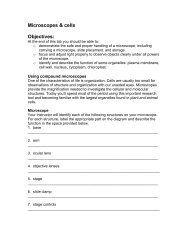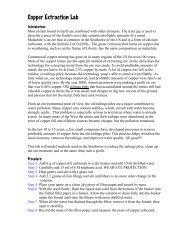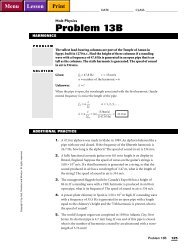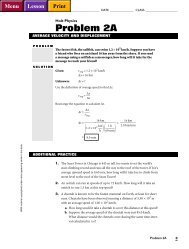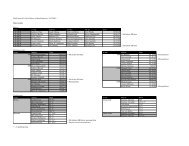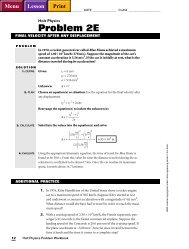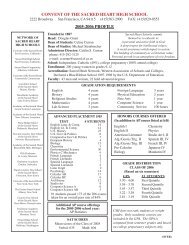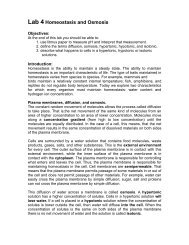Problem 8B
Problem 8B
Problem 8B
Create successful ePaper yourself
Turn your PDF publications into a flip-book with our unique Google optimized e-Paper software.
NAME ______________________________________ DATE _______________ CLASS ____________________<br />
Holt Physics<br />
<strong>Problem</strong> <strong>8B</strong><br />
ROTATIONAL EQUILIBRIUM<br />
PROBLEM<br />
SOLUTION<br />
1. DEFINE<br />
In 1960, a polar bear with a mass of 9.00 × 10 2 kg was discovered in<br />
Alaska. Suppose this bear crosses a 12.0 m long horizontal bridge that<br />
spans a gully. The bridge consists of a wide board that has a uniform<br />
mass of 2.50 × 10 2 kg and whose ends are loosely set on either side of the<br />
gully. When the bear is two-thirds of the way across the bridge, what is<br />
the normal force acting on the board at the end farthest from the bear<br />
Given:<br />
Unknown: F n,1 = <br />
Diagram:<br />
m b = mass of bridge = 2.50 × 10 2 kg<br />
m p = mass of polar bear = 9.00 × 10 2 kg<br />
l = length of bridge = 12.0 m<br />
g = 9.81 m/s 2<br />
12.0 m<br />
F n,1<br />
mb<br />
m p<br />
F n,2<br />
2. PLAN<br />
Choose the equation(s) or situation:<br />
Apply the first condition of equilibrium: The unknowns in this problem are the<br />
normal forces exerted upward by the ground on either end of the board. The known<br />
quantities are the weights of the bridge and the polar bear. All of the forces are in the<br />
vertical (y) direction.<br />
F y = F n,1 + F n,2 − m b g − m p g = 0<br />
Because there are two unknowns and only one equation, the solution cannot be<br />
obtained from the first condition of equilibrium alone.<br />
Choose a point for calculating net torque: Choose the end of the bridge farthest<br />
from the bear as the pivot point. The torque produced by F n,1 will be zero.<br />
Apply the second condition of equilibrium: The torques produced by the bridge’s<br />
and polar bear’s weights are clockwise and therefore negative. The normal force on<br />
the end of the bridge opposite the axis of rotation exerts a counterclockwise (positive)<br />
torque.<br />
t net =−(m b g)d b − (m p g)d p + F n,2 d 2 = 0<br />
Copyright © by Holt, Rinehart and Winston. All rights reserved.<br />
88<br />
Holt Physics <strong>Problem</strong> Workbook
NAME ______________________________________ DATE _______________ CLASS ____________________<br />
The lever arm for the bridge’s weight (d b ) is the distance from the bridge’s<br />
center of mass to the pivot point, or half the bridge’s length. The lever arm for the<br />
polar bear is two-thirds the bridge’s length. The lever arm for the normal force<br />
farthest from the pivot equals the entire length of the bridge.<br />
d b = ⎯ 1 2 ⎯ l , d p = ⎯ 2 3 ⎯ l , d 2 = l<br />
The torque equation thus takes the following form:<br />
m b gl 2m p gl<br />
t net =−⎯ − ⎯ +F n,2l = 0<br />
2 3<br />
Rearrange the equation(s) to isolate the unknowns:<br />
m b gl 2m p gl<br />
F n,2 = + = <br />
⎯ m b<br />
⎯ + ⎯ 2 m<br />
⎯ ⎯ p<br />
2 3 <br />
g<br />
2l<br />
⎯ 3l<br />
F n,1 = m b g + m p g − F n,2<br />
3. CALCULATE<br />
Substitute the values into the equation(s) and solve:<br />
F n,2 = <br />
⎯ 2.50 × 10 2 kg<br />
⎯ + ⎯ (2)(9.00 × 10 2 kg)<br />
⎯<br />
2<br />
3 <br />
(9.81 m/s 2 )<br />
F n,2 = (125 kg + 6.00 × 10 2 kg)(9.81 m/s 2 )<br />
F n,2 = (725 kg)(9.81 m/s 2 )<br />
F n,2 = 7.11 × 10 3 N<br />
F n,1 = (2.50 × 10 2 kg)(9.81 m/s 2 ) + (9.00 × 10 2 kg)(9.81 m/s 2 )<br />
− 7.11 × 10 3 N<br />
F n,1 = 2.45 × 10 3 N + 8.83 × 10 3 N − 7.11 × 10 3 N<br />
F n,1 =<br />
4.17 × 10 3 N<br />
Copyright © by Holt, Rinehart and Winston. All rights reserved.<br />
4. EVALULATE<br />
ADDITIONAL PRACTICE<br />
The sum of the upward normal forces exerted on the ends of the bridge must<br />
equal the weight of the polar bear and the bridge. (The individual normal forces<br />
change as the polar bear moves across the bridge.)<br />
(4.17 kN + 7.11 kN) = (2.50 × 10 2 kg + 9.00 × 10 2 kg)(9.81 m/s 2 )<br />
11.28 kN = 11.28 × 10 3 N<br />
1. The heaviest sea sponge ever collected had a mass of 40.0 kg, but after<br />
drying out, its mass decreased to 5.4 kg. Suppose two loads equal to the<br />
wet and dry masses of this giant sponge hang from the opposite ends of a<br />
horizontal meterstick of negligible mass and that a fulcrum is placed<br />
70.0 cm from the larger of the two masses. How much extra force must<br />
be applied to the end of the meterstick with the smaller mass in order to<br />
provide equilibrium<br />
2. A Saguaro cactus with a height of 24 m and an estimated age of 150 years<br />
was discovered in 1978 in Arizona. Unfortunately, a storm toppled it in<br />
1986. Suppose the storm produced a torque of 2.00 × 10 5 N •m that<br />
acted on the cactus. If the cactus could withstand a torque of only<br />
<strong>Problem</strong> <strong>8B</strong> 89
NAME ______________________________________ DATE _______________ CLASS ____________________<br />
1.2 × 10 5 N •m, what minimum force could have been applied to the cactus<br />
keep it standing At what point and in what direction should this<br />
force have been applied Assume that the cactus itself was very strong<br />
and that the roots were just pulled out of the ground.<br />
3. In 1994, John Evans set a record for brick balancing by holding a load of<br />
bricks with a mass of 134 kg on his head for 10 s. Another, less extreme,<br />
method of balancing this load would be to use a lever. Suppose a board<br />
with a length of 7.00 m is placed on a fulcrum and the bricks are set on<br />
one end of the board at a distance of 2.00 m from the fulcrum. If a force<br />
is applied at a right angle to the other end of the board and the force has<br />
a direction that is 60.0° below the horizontal and away from the bricks,<br />
how great must this force be to keep the load in equilibrium Assume the<br />
board has negligible mass.<br />
4. In 1994, a vanilla ice lollipop with a mass of 8.8 × 10 3 kg was made in<br />
Poland. Suppose this ice lollipop was placed on the end of a lever 15 m in<br />
length. A fulcrum was placed 3.0 m from the lollipop so that the lever<br />
made an angle of 20.0° with the ground. If the force was applied perpendicular<br />
to the lever, what was the smallest magnitude this force could<br />
have and still lift the lollipop Neglect the mass of the lever.<br />
5. The Galápagos fur seals are very small. An average adult male has a mass<br />
of 64 kg, and a female has a mass of only 27 kg. Suppose one average<br />
adult male seal and one average adult female seal sit on opposite ends of<br />
a light board that has a length of 3.0 m. How far from the male seal<br />
should the board be pivoted in order for equilibrium to be maintained<br />
6. Goliath, a giant Galápagos tortoise living in Florida, has a mass of 3.6 ×<br />
10 2 kg. Suppose Goliath walks along a heavy board above a swimming<br />
pool. The board has a mass of 6.0 × 10 2 kg and a length of 15 m, and it is<br />
placed horizontally on the edge of the pool so that only 5.0 m of it extends<br />
over the water. How far out along this 5.0 m extension of the board<br />
can Goliath walk before he falls into the pool<br />
7. The largest pumpkin ever grown had a mass of 449 kg. Suppose this<br />
pumpkin was placed on a platform that was supported by two bases<br />
5.0 m apart. If the left base exerted a normal force of 2.70 × 10 3 N on the<br />
platform, how far must the pumpkin have been from the platform’s left<br />
edge The platform had negligible mass.<br />
8. In 1991, a giant stick of Brighton rock (a type of rock candy) was made<br />
in England. The candy had a mass of 414 kg and a length of 5.00 m.<br />
Imagine that the candy was balanced horizontally on a fulcrum. A child<br />
with a mass of 40.0 kg sat on one end of the stick. How far must the fulcrum<br />
have been from the child in order to maintain equilibrium<br />
Copyright © by Holt, Rinehart and Winston. All rights reserved.<br />
90<br />
Holt Physics <strong>Problem</strong> Workbook
Additional Practice <strong>8B</strong><br />
Givens<br />
1. t 1 = 2.00 × 10 5 N •m<br />
t 2 = 1.20 × 10 5 N •m<br />
h = 24 m<br />
Solutions<br />
Apply the second condition of equilibrium, choosing the base of the cactus as the<br />
pivot point.<br />
t net = t 1 − t 2 − Fd(sin q) = 0<br />
Fd(sin q) = t 1 − t 2<br />
For F to be minimum, d and sin q must be maximum. This occurs when the force is<br />
perpendicular to the cactus (q = 90°) and is applied to the top of the cactus (d = h =<br />
24 m).<br />
F min = ⎯ t 1 − t 2 2.00 × 10 5 N •m − 1.20 × 10 5 N •m<br />
⎯ = ⎯⎯⎯⎯<br />
h<br />
24 m<br />
8.0 × 10 4 N•m<br />
F min = ⎯⎯ = 3.3 × 10 3 N applied to the top of the cactus<br />
24 m<br />
2. m 1 = 40.0 kg<br />
m 2 = 5.4 kg<br />
d 1 = 70.0 cm<br />
d 2 = 100.0 cm − 70.0 cm<br />
= 30.0 cm<br />
g = 9.81 m/s 2<br />
Apply the first condition of equilibrium.<br />
F n − m 1 g − m 2 g − F applied = 0<br />
F n = m 1 g + m 2 g + F applied = (40.0 kg)(9.81 m/s 2 ) + (5.4 kg)(9.81 m/s 2 ) + F applied<br />
F n = 392 N + 53 N + F applied = 455 N + F applied<br />
Apply the second condition of equilibrium, using the fulcrum as the location for the<br />
axis of rotation.<br />
F applied d 2 + m 2 gd 2 − m 1 gd 1 = 0<br />
F applied = ⎯ m 1gd 1 − m 2 gd 2 (40.0 kg)(9.81 m/s 2 )(0.700 m) − (5.4 kg)(9.81 m/s 2 )(0.300 m)<br />
⎯ = ⎯⎯⎯⎯⎯⎯⎯<br />
d2<br />
0.300 m<br />
275 N•m − 16 N•m 259 N•m<br />
F applied = ⎯⎯ = ⎯ 0.300 m 0.300 m<br />
F applied = 863 N<br />
Substitute the value for F applied into the first-condition equation to solve for F n .<br />
F n = 455 N + 863 N = 1318 N<br />
II<br />
Copyright © by Holt, Rinehart and Winston. All rights reserved.<br />
3. m = 134 kg<br />
d 1 = 2.00 m<br />
d 2 = 7.00 m − 2.00 m = 5.00 m<br />
q = 60.0°<br />
g = 9.81 m/s 2<br />
Apply the first condition of equilibrium in the x and y directions.<br />
F x = F applied (cos q) − F f = 0<br />
F y = F n − F applied (sin q) − mg = 0<br />
To solve for F applied , apply the second condition of equilibrium, using the fulcrum as<br />
the pivot point.<br />
F applied (sin q)d 2 − mgd 1 = 0<br />
mgd F applied = ⎯ 1 (134 kg)(9.81 m/s 2 )(2.00 m)<br />
⎯ = ⎯⎯⎯<br />
d2 (sin<br />
q) (5.00 m)(sin 60.0°)<br />
F applied = 607 N<br />
Substitute the value for F applied into the first-condition equations to solve for F n and<br />
F f .<br />
F n = F applied (sin q) + mg = (607 N)(sin 60.0°) + (134 kg)(9.81 m/s 2 )<br />
F n = 526 N + 1.31 × 10 3 N = 1.84 × 10 3 N<br />
F f = F applied (cos q) = (607 N)(cos 60.0°) =<br />
304 N<br />
Section Two—<strong>Problem</strong> Workbook Solutions II Ch. 8–3
Givens<br />
Solutions<br />
II<br />
4. m = 8.8 × 10 3 kg<br />
d 1 = 3.0 m<br />
d 2 = 15 m − 3.0 m = 12 m<br />
q = 20.0°<br />
g = 9.81 m/s 2<br />
6. m 1 = 3.6 × 10 2 kg<br />
m 2 = 6.0 × 10 2 kg<br />
l = 15 m<br />
l 1 = 5.0 m<br />
g = 9.81 m/s 2<br />
Apply the first condition of equilibrium in the x and y directions.<br />
F x = F fulcrum,x − F (sin q) = 0<br />
F y F fulcrum,y − F (cos q) − mg = 0<br />
To solve for F, apply the second condition of equilibrium •, using the fulcrum as the<br />
pivot point.<br />
Fd 2 − mg d 1 (cos q) = 0<br />
F = ⎯ mg d 1 ( cos q) (8.8 × 10 3 kg)(9.81 m/s 2 )(3.0 m)(cos 20.0°)<br />
⎯ = ⎯⎯⎯⎯⎯<br />
d<br />
12 m<br />
2<br />
F = 2.0 × 10 4 N<br />
Substitute the value for F into the first-condition equations to solve for the components<br />
of F fulcrum .<br />
F fulcrum,x = F (sin q) = (2.0 × 10 4 N)(sin 20.0°)<br />
F fulcrum,x = 6.8 × 10 3 N<br />
F fulcrum,y = F (cos q) + mg = (2.0 × 10 4 N)(cos 20.0°) + (8.8 × 10 4 kg)(9.81 m/s 2 )<br />
F fulcrum,y = 1.9 × 10 4 N + 8.6 × 10 5 N = 8.8 × 10 5 N<br />
5. m 1 = 64 kg<br />
Apply the first condition of equilibrium to solve for F applied .<br />
m 2 = 27 kg<br />
F n − m 1 g − m 2 g − F applied = 0<br />
d 1 = d 2 = ⎯ 3.0 0m ⎯ = 1.50 m<br />
F applied = F n − m 1 g − m 2 g = 1.50 × 10 3 N − (64 kg)(9.81 m/s 2 ) − (27 kg)(9.81 m/s 2 )<br />
2<br />
F n = 1.50 × 10 3 F applied = 1.50 × 10 3 N − 6.3 × 10 2 N − 2.6 × 10 3 N = 6.1 × 10 2 N<br />
N<br />
g = 9.81 m/s 2 To solve for the lever arm for F applied , apply the second condition of equilibrium,<br />
using the fulcrum as the pivot point.<br />
F applied d + m 2 g d 2 − m 1 g d 1 = 0<br />
d = ⎯ m 1 gd1<br />
− m2 gd<br />
⎯ 2<br />
=<br />
Fapplied<br />
9.4 × 10 2 N •m − 4.0 × 10 2 N •m<br />
d = ⎯⎯⎯⎯ =<br />
6.1 × 10 2 N<br />
Apply the second condition of equilibrium, using the pool’s edge as the pivot point.<br />
Assume the total mass of the board is concentrated at its center.<br />
m 1 g d − m 2 g <br />
− l 1 = 0<br />
m 2 g <br />
⎯ l ⎯<br />
2<br />
l<br />
⎯<br />
− l 1<br />
m 2<br />
⎯l ⎯ − l 1<br />
2<br />
d = ⎯ = ⎯<br />
m1 g<br />
m1<br />
2<br />
(64 kg)(9.81 m/s 2 )(1.50 m) − (27 kg)(9.81 m/s 2 )(1.50 m)<br />
⎯⎯⎯⎯⎯⎯<br />
6.1 × 10 2 N<br />
5.4 × 10 2 N •m<br />
⎯⎯<br />
6.1 × 10 2 N<br />
d = 0.89 m from the fulcrum, on the same side as the less massive seal<br />
(6.0 × 10 2 kg)<br />
(6.0 × 10 2 kg)(7.5 m − 5.0 m)<br />
d =<br />
<br />
⎯ 15 m<br />
⎯ − 5.0 m<br />
2<br />
⎯⎯⎯<br />
<br />
= ⎯⎯⎯ =<br />
3.6 × 10 2 kg<br />
3.6 × 10 2 kg<br />
Copyright © by Holt, Rinehart and Winston. All rights reserved.<br />
(6.0 × 10 2 kg)(2.5 m)<br />
⎯⎯⎯<br />
3.6 × 10 2 kg<br />
d = 4.2 m from the pool’s edge<br />
II Ch. 8–4<br />
Holt Physics Solution Manual
Givens<br />
Solutions<br />
7. m = 449 kg<br />
Apply the first condition of equilibrium to solve for F 2 .<br />
l = 5.0 m<br />
F 1 + F 2 − mg = 0<br />
F 1 = 2.70 × 10 3 N<br />
F 2 = mg − F 1<br />
g = 9.81 m/s 2 F 2 = (449 kg)(9.81 m/s 2 ) − 2.70 × 10 3 N = 4.40 × 10 3 N − 2.70 × 10 3 N = 1.70 × 10 3 N<br />
Apply the second condition of equilibrium, using the left end of the platform as the<br />
pivot point.<br />
F 2 l − m g d = 0<br />
F (1.70 × 10 3 2 l<br />
N)(5.0 m)<br />
d = ⎯ = ⎯⎯⎯<br />
mg (449 kg)(9.81 m/s 2 )<br />
d =<br />
1.9 m from the platform’s left end<br />
8. m 1 = 414 kg<br />
Apply the first condition of equilibrium to solve for F 2 .<br />
l = 5.00 m<br />
F 1 + F 2 − m 1 g − m 2 g = 0<br />
m 2 = 40.0 kg<br />
F 2 = m 1 g + m 2 g − F 1 = (m 1 + m 2 ) g − F 1<br />
F 1 = 50.0 N<br />
F 2 = (414 kg + 40.0 kg)(9.81 m/s 2 ) − 50.0 N = (454 kg)(9.81 m/s 2 ) − 50.0 N = 4.45 ×<br />
g = 9.81 m/s 2 10 3 N − 50.0 N<br />
F 2 = 4.40 × 10 3 N<br />
Apply the second condition of equilibrium, using the supported end (F 1 ) of the stick<br />
as the rotation axis.<br />
F 2 d − m 1 g <br />
− m 2 g l = 0<br />
l<br />
⎯2<br />
⎯m 1<br />
⎯ + m 2<br />
2 g l<br />
d = ⎯⎯ = F2<br />
⎯414 kg<br />
⎯ + 40.0 kg<br />
2 <br />
(9.81 m/s 2 )(5.0 m)<br />
⎯⎯⎯⎯<br />
4.40 × 10 3 N<br />
(207 kg + 40.0 kg)(9.81 m/s 2 )(5.00 m)<br />
d = ⎯⎯⎯⎯ =<br />
4.40 × 10 3 N<br />
(247 kg)(9.81 m/s 2 )(5.00 m)<br />
⎯⎯⎯<br />
4.40 × 10 3 N<br />
II<br />
Copyright © by Holt, Rinehart and Winston. All rights reserved.<br />
Additional Practice 8C<br />
1. R = 50.0 m<br />
M = 1.20 × 10 6 kg<br />
t = 1.0 × 10 9 N •m<br />
2. M = 22 kg<br />
R = 0.36 m<br />
t = 5.7 N •m<br />
d = 2.75 m from the supported end<br />
a = ⎯ t I ⎯ = ⎯ t 1.0 × 10 9 N •m<br />
⎯<br />
MR 2 = ⎯⎯⎯<br />
(1.20 × 10 6 kg)(50.0 2 )<br />
a = 0.33 rad/s 2<br />
a = ⎯ t I ⎯ = ⎯ t 5.7 N•m<br />
⎯<br />
MR 2 = ⎯⎯<br />
(22 kg)(0.36 m)<br />
2<br />
a = 2.0 rad/s 2<br />
Section Two—<strong>Problem</strong> Workbook Solutions II Ch. 8–5




